Book contents
- Understanding Forensic DNA
- Understanding Life
- Understanding Forensic DNA
- Copyright page
- Reviews
- Dedication
- Contents
- Foreword
- Preface
- Acknowledgments
- 1 Biological Identification
- 2 Before DNA
- 3 First-Generation Forensic DNA
- 4 STR Methods and Loci
- 5 DNA Analysis and Interpretation: Single-Source Samples and Simple Mixtures
- 6 The Curse of Sensitivity
- 7 From Mothers and Fathers
- 8 Emerging Technologies
- 9 Emerging Issues
- Concluding Remarks
- Summary of Common Misunderstandings
- References and Further Reading
- Figure Credits
- Index
7 - From Mothers and Fathers
Published online by Cambridge University Press: 02 September 2022
- Understanding Forensic DNA
- Understanding Life
- Understanding Forensic DNA
- Copyright page
- Reviews
- Dedication
- Contents
- Foreword
- Preface
- Acknowledgments
- 1 Biological Identification
- 2 Before DNA
- 3 First-Generation Forensic DNA
- 4 STR Methods and Loci
- 5 DNA Analysis and Interpretation: Single-Source Samples and Simple Mixtures
- 6 The Curse of Sensitivity
- 7 From Mothers and Fathers
- 8 Emerging Technologies
- 9 Emerging Issues
- Concluding Remarks
- Summary of Common Misunderstandings
- References and Further Reading
- Figure Credits
- Index
Summary
So far, we have focused on DNA types in which one allele is from the father and one from the mother. However, three other sources of DNA come from only one parent, and all can be employed in forensic testing. One is mitochondrial DNA (from the mother in all her children), and the other two are STR sites on the Y chromosome (from the father in his sons) and STR sites on the X chromosome (from the mother in her sons). These DNA sources are lineage markers, since they can be traced back generations through our family trees. Lineage markers are valuable in missing person cases where DNA from the person of interest is not available. Mitochondrial DNA (mtDNA) has been used in historical cases, such as identifying soldiers killed in past conflicts. We will explore these and other examples in this chapter.
Keywords
- Type
- Chapter
- Information
- Understanding Forensic DNA , pp. 109 - 124Publisher: Cambridge University PressPrint publication year: 2022

